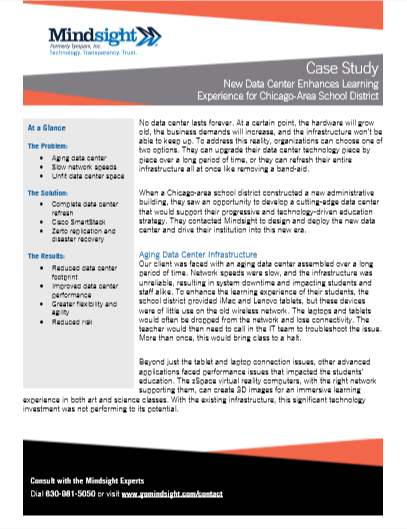August 28, 2018 by Siobhan Climer
Despite initial worries over education budget cuts in 2017, the Federal Department of Education’s budget increased to $70.9 billion, an almost 4% increase over the previous budget. Part of this funding is directed toward Title IV, within which Title IV-A resides. Why is Title IV-A important to IT leadership? It is the Student Support and Academic Enrichment (SSAE) grant program through which many teachers are trained in technology.
For Directors of IT, CTOs, and CIOs, this is especially important. More teachers trained in technology tools means an increased interest in investing in technology solutions for students. This might mean bringing in new tools directly linked to student programming or tools for managing student data in the school environment. When it comes to IT budget planning in education in 2018, leadership will need to plan to support administrators, teachers, and students in the use and maintenance of these technology tools while also focusing on long-term strategy.
Find out more about creating a long-term strategy in our Technology Roadmap eBook today. Mindsight performs assessments for clients on the regular basis to help them improve operations, reduce risks, and better manage costs.
Resources For IT Budget Planning
 A great resource for IT budget planning in education is the Government Finance Officers Association (GFOA). The GFOA represents public finance officials, and the association’s “mission is to advance excellent in state and local government financial management”. While the GFOA provides many tools, IT leadership may want to start with the best practices in school district budgeting.
A great resource for IT budget planning in education is the Government Finance Officers Association (GFOA). The GFOA represents public finance officials, and the association’s “mission is to advance excellent in state and local government financial management”. While the GFOA provides many tools, IT leadership may want to start with the best practices in school district budgeting.
Part of what makes IT budget planning in education so difficult is the often unstable and ever-changing status of education reforms, complicated grant programs, and various district-specific goals. Every funding decision needs to not only support the best interests of the environment – whether that’s the ventilation system of an on-premise data center or the deployment model for a cloud storage solution – but also the needs of students. Prioritizing financial investments must always come back to the primary mission of the school district, the education of its students, but that often means thinking about technology investments in new ways.
Current State Analysis And Assessment
In a best-case scenario, IT budget planning in education would be easy, based on comprehensive information systems supporting a data-driven budget based on educational outcomes. As most IT leaders already know, the reality is usually far from the ideal. Instead of a data-driven comprehensive IT system, most school districts have a “duct-tape IT model”: basically, a gap-driven piece-meal system developed over decades of conflicting priorities and changing demands. Strategy has usually gone out the window. In these school districts, IT leadership is often tasked with putting out fires instead of creating a strategic IT system that meets district goals, enhances student learning environments, and builds on itself for the future.
How can we change this? To get started, IT leadership needs to perform a current technology assessment before IT budget planning can begin. Find answers to the following questions:
- What technologies are currently in use?
- How are school district staff using technology (i.e. lesson planning, data processing, data storage, etc.)?
- Where are the gaps, failure points, and security risks in the current system?
- What support is available for funding (i.e. grants, private funding)?
- How do local, state, and federal regulations impact the school IT environment?
- What goals do the department and school district have?
It’s no secret that funding can be scarce in education; performing a current state analysis enables leadership to determine gaps and risks, providing context to as IT budget planning in education takes off.
Involve The Community – Local IT Budget Planning In Education
 Research has shown time and time again that linking spending to student outcomes is a challenging – if not impossible – endeavor. Many factors outside of the school environment can impact student learning. As the Rennie Center states in their Smart School Budgeting toolkit, “Ultimately, if resources had a clear and consistent effect on student performance, policy-making and budgeting would be straightforward. But it does not, and it is not.”
Research has shown time and time again that linking spending to student outcomes is a challenging – if not impossible – endeavor. Many factors outside of the school environment can impact student learning. As the Rennie Center states in their Smart School Budgeting toolkit, “Ultimately, if resources had a clear and consistent effect on student performance, policy-making and budgeting would be straightforward. But it does not, and it is not.”
What we do know is that IT budget planning in education is more successful when local community input is sought and included in the budget. To create a sustainable IT strategy, coordinated strategies implemented across the entire system are necessary; otherwise, you’ll just be adding more duct-tape to the process. And we already know that doesn’t work.
While it can be difficult to target the achievement gap, align resources to learning improvement agendas, manage district politics, and find the right human resources for districts, a strong IT budget plan begins with including each school in the spending allocation planning, calculating budgets based on individual student needs, and supporting students and staff with a strategic IT system.
Types Of IT School Budgets
Line-items, Percentage Add-ons, Zero-based, Program and Planning, Performance-based, Site-based, Outcome-based, Student-based…
There are at least a dozen different ways to engage in IT budget planning in education. Increasingly, school districts and IT leadership are utilizing multiple budget types to provide a strategic and specific budget plan for an individual district. What works in the Bronx won’t work in Dix, and what works in Dix won’t work in Chicago. Site-based budget planning models have become more popular for this very reason. This is where the budget is planned based on each site within the district, enabling leadership to focus on student-based initiatives while still considering the individual needs of students.
Thinking Outside The Tech Tool Box
Adding a new tool – even a great one – only works if the tool is an integrated part of IT strategy. Software-as-a-Service (SaaS) cloud deployment solutions, mobile technology tools for students, and secure data storage are all areas rich for investment, but they risk being duct-taped on. As you begin your IT budget planning in education, be sure to perform a technology roadmap assessment. Mindsight’s expert engineers can go through your environment, create a strategic roadmap that unites district goals with student technology needs, and keep your school district ahead of the curve.
To see what a technology roadmap looks like in practice, check out one of our case studies from the education sector.
Contact us today to find out how to support a long-term tech plan in your district.
Like what you read?
About Mindsight
Mindsight, a Chicago IT services provider, is an extension of your team. Our culture is built on transparency and trust, and our team is made up of extraordinary people – the kinds of people you would hire. We have one of the largest expert-level engineering teams delivering the full spectrum of IT services and solutions, from cloud to infrastructure, collaboration to contact center. Our highly-certified engineers and process-oriented excellence have certainly been key to our success. But what really sets us apart is our straightforward and honest approach to every conversation, whether it is for an emerging business or global enterprise. Our customers rely on our thought leadership, responsiveness, and dedication to solving their toughest technology challenges.
Contact us at GoMindsight.com.
About The Author
Siobhan Climer, Science and Technology Writer for Mindsight, writes about technology trends in education, healthcare, and business. She previously taught STEM programs in elementary classrooms and museums, and writes extensively about cybersecurity, disaster recovery, cloud services, backups, data storage, network infrastructure, and the contact center. When she’s not writing tech, she’s writing fantasy, gardening, and exploring the world with her twin two-year old daughters. Find her on twitter @techtalksio.




